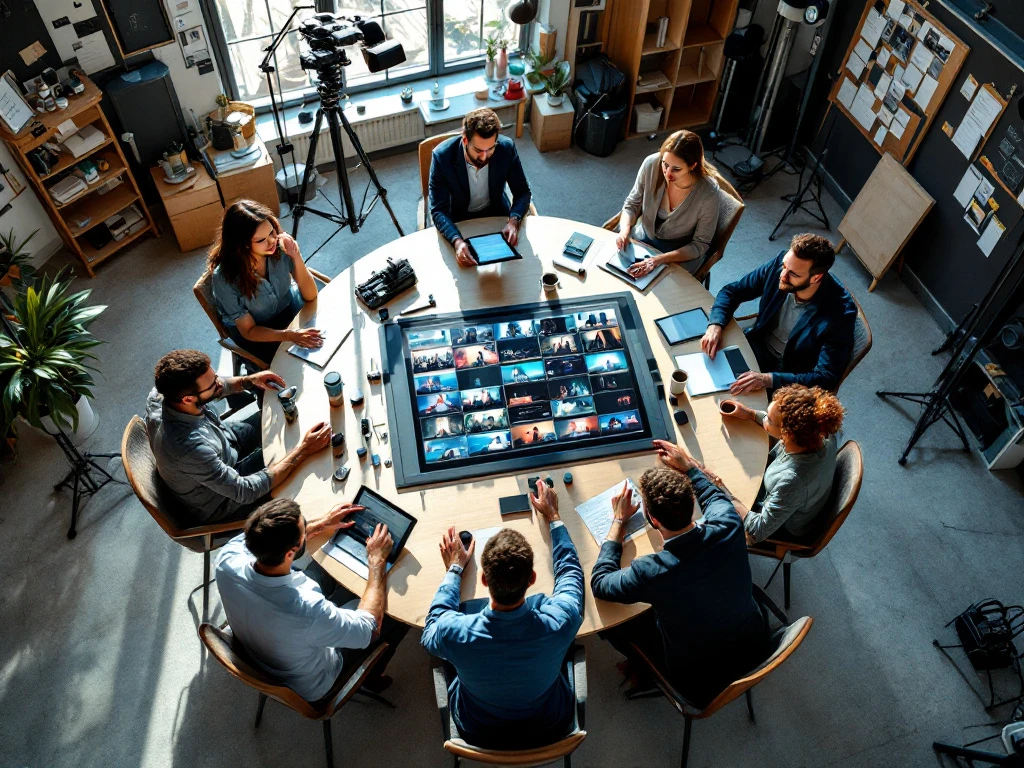Understanding Video Co-creation
Video co-creation represents a revolutionary approach to producing high-quality video content within organisations. At its core, video co-creation is a collaborative production method where:
- Employees across departments capture footage
- Professional editors handle the post-production work
- Authentic perspectives blend with technical expertise
This innovative approach fundamentally differs from traditional video production, which typically requires hiring expensive camera crews or relying completely on in-house video specialists for every project.
Unlike conventional video production that might bottleneck with limited resources, video co-creation democratises the process by empowering employees to become content creators. This collaborative video production method leverages the authentic perspectives of team members who understand the company’s values and culture intimately. Rather than outsourcing the entire production, co-creation maintains professional quality while distributing the workload in a way that maximises efficiency and authenticity.
The fundamental principle of co-creation—“you film, we edit”—creates a perfect balance of authenticity and professional polish. Employees capture genuine moments and insights from within the organisation, while video experts transform this raw footage into compelling, branded content that meets professional standards. This harmonious blend of internal knowledge and external expertise is what makes video co-creation such a powerful approach for modern corporate communication.
The Process of Video Co-creation
Successful video co-creation follows a structured yet flexible workflow designed to maximise collaboration while ensuring professional results. The process typically includes:
- Ideation and planning: Key stakeholders determine video objectives, messaging, and basic structure
- Training and preparation: Employees receive guidance on filming techniques appropriate for their equipment
- Content capture: Team members film relevant footage independently
- Professional editing: Experts transform raw footage into cohesive, polished productions
- Feedback and refinement: Collaborative review ensures the final product meets all objectives
Throughout the editing process, continuous feedback loops between the filming team and editors ensure the final product meets expectations whilst maintaining professional standards. This collaborative approach creates numerous opportunities for refinement and creative input from all stakeholders. The iterative nature of video co-creation leads to superior results compared to isolated production methods, as each participant contributes their unique expertise and perspective to create truly authentic content that resonates within the organisation.
Benefits of Video Co-creation
The benefits of video co-creation are substantial and multifaceted for organisations seeking to expand their video communication strategy:
- Cost efficiency: Eliminates the need for external camera crews for every project
- Faster production: Dramatically shortens timelines for creating video content
- Greater authenticity: Captures genuine moments that outside production teams might miss
- Knowledge building: Develops valuable video production skills within the organisation
- Global scalability: Enables consistent video quality across all locations worldwide
- Cross-departmental collaboration: Breaks down silos and encourages innovative storytelling
Co-creation also offers unparalleled flexibility across global operations. Since employees can film anywhere in the world, organisations can maintain consistent video quality and branding across all locations whilst showcasing authentic local perspectives. The distributed nature of content capture combined with centralised editing creates a perfect balance—enabling unified messaging with diverse visual representation.
Case Studies of Successful Video Co-creation
Friesland Campina: This global dairy cooperative demonstrates the power of video co-creation in action. By implementing a co-creation strategy, they:
- Empowered employees across multiple countries to capture authentic footage
- Maintained consistent brand messaging through professional editing
- Created a compelling promotional film balancing local authenticity with professional polish
- Achieved results that would have been prohibitively expensive using traditional methods
VGZ: This major health insurance company transformed their internal news distribution through video co-creation by:
- Establishing a monthly news show with employee-filmed segments
- Professionally editing content into engaging broadcasts
- Increasing employee engagement as colleagues became both creators and audience
- Achieving higher viewership and retention compared to previous approaches
Heembouw: This financial services organisation successfully utilised video co-creation to document their corporate culture by enabling employees to capture genuine workplace moments, creating promotional material that genuinely reflected company values while maintaining professional presentation standards.
Implementing Video Co-creation in Your Strategy
Successfully integrating video co-creation into your communication strategy requires thoughtful planning and the right support systems. Follow these key steps:
- Identify video champions across departments who show interest in becoming content creators
- Invest in proper training covering basic filming techniques, scriptwriting, and interview skills
- Establish clear guidelines including shot lists, interview templates, and storyboard formats
- Implement streamlined workflows for footage collection and feedback
- Start with smaller projects to build confidence before tackling complex productions
For optimal results, begin with lower-stakes video projects such as:
- Internal announcements
- Team introductions
- Event recaps
Remember that video co-creation is a continuous learning journey—each project builds capacity within your organisation. By embracing feedback and celebrating success, you’ll create a positive cycle that improves both skills and engagement, leading to increasingly impressive results from your video co-creation efforts.
What Makes Video Co-creation Different from Traditional Video Production?
Video co-creation fundamentally transforms the production model in several key ways:
| Traditional Production | Video Co-creation |
|---|---|
| Centralised responsibilities | Distributed expertise-based tasks |
| Quality vs. quantity tradeoff | High quality and greater frequency |
| Scheduling bottlenecks | Organic, flexible filming opportunities |
| Dependency on external resources | Building internal capacity over time |
The distributed nature of co-creation creates significant workflow advantages. Traditional production often creates scheduling constraints, as filming crews must coordinate with multiple stakeholders across limited timeframes. With co-creation, filming can happen organically when opportunities arise, with employees capturing content during their normal work activities.
Perhaps most importantly, video co-creation builds lasting capacity within your organisation. While traditional production leaves you dependent on external resources for future projects, co-creation gradually develops internal video expertise. By embracing video co-creation as your primary video strategy, you transform video from an occasional luxury into an integrated, sustainable communication channel that enhances your organisation’s overall communication capabilities.

